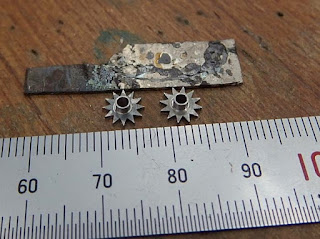They were rubbed with many sandpapers again and again. Just a little more...
After buffing...
Bluing is the next. On the thin copper plate which filled brass chips, they are heated until their surface color will change to deep blue. To heat them at the same time might cause uneven effect. Let's do it one by one.
It has become straw color.
Purple. Nearing the end.
It seems they were done well.
Brass bush was fitted to the hour hand. And attached to the movement.














































